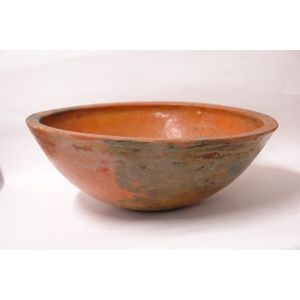Barry Brickell Salt Glaze Boat-Form Bowl
An important Barry Brickell salt glaze boat-form bowl, the partial fluted and tapered flat rim coming to a double knob point, lustrous dark 'coal fired' salt glaze effects, ovoid foot. Unmarked. 21 x 24 x 155. Vintage typed paper label to base: EXHIB. FAENZA'. Exhibited: 'N.Z. at the V & A' 1972, illustrated New Zealand Potter, Vol. 14, No. 1, Autumn 1972'.
You must be a subscriber, and be logged in to view price and dealer details.
Subscribe Now to view actual auction price for this item
When you subscribe, you have the option of setting the currency in which to display prices to $Au, $US, $NZ or Stg.
This item has been sold, and the description, image and price are for reference purposes only.
- Important - Important is a word used in the antique trade to indicate an object should be ranked above other similar objects, and is therefore more valuable.
The object could be considered important because it is by a famous designer or maker, has been shown at a major exhibition, is of exquisite workmanship, is rare or is a "one-off", was made for an important patron, and so on.
Even further up the pecking order are objects that are described in catalogue descriptions as highly important or extraordinarily important. - Oviform /ovoid - The outline loosely resembling the shape of an egg.
- Salt Glazed - Salt glazing involves throwing salt into the kiln when it is at its highest temperature, usually around 2,300 to 2,400 degrees Fahrenheit (1,260 to 1,320 degrees Celsius). The salt vaporizes and forms a glaze on the surface of the pottery, creating a range of effects depending on how the salt is applied and the firing conditions. This glazing method was first developed in Germany in the 15th century and quickly became popular throughout Europe and North America. It was particularly popular for making stoneware pottery, such as jugs, crocks, and other utilitarian objects.
Salt glazes can produce a range of colors, including gray, brown, blue, and even pink or purple in some cases. The texture of the glaze is typically rough and pebbled, with a matte or satin finish. The process of salt glazing can be unpredictable, with variations in temperature and salt application leading to subtle variations in the finished product.
Salt glazing is still used by potters and ceramic artists although it is less common than it was in the past.
This item has been included into following indexes:
Visually similar items

An old Fijian Lapita type large pottery bowl, the flat rim with incised repeating dotted swag decoration, gum glaze. Diameter 46 cm. Provenance: The Collection of Joy and Dennis Hanna.
Sold by
in
for
You can display prices in $Au, $US, $NZ or Stg.

Gwyn Hanssen Piggot Pottery jug, unmarked, 7 cm high, 9 cm across
Sold by
in
for
You can display prices in $Au, $US, $NZ or Stg.

Chinese carved turquoise bowl measures 10 cm D
Sold by
in
for
You can display prices in $Au, $US, $NZ or Stg.

Estelle Martin, bowl, anagama fired. Impressed mark. Height 10 cm. Diameter 17.5 cm
Sold by
in
for
You can display prices in $Au, $US, $NZ or Stg.
